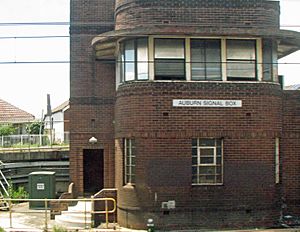Auburn Railway Signal Box facts for kids
Quick facts for kids Auburn Railway Signal Box |
|
|---|---|

Auburn Railway Signal Box, 2018
|
|
| Location | Main Suburban railway line, Auburn, New South Wales, Australia |
| Built | 1954 |
| Architect | New South Wales Government Railways |
| Owner | RailCorp |
| Official name: Auburn Railway Signal Box; Railway Signal Box | |
| Type | state heritage (built) |
| Designated | 2 April 1999 |
| Reference no. | 1023 |
| Type | Signal Box |
| Category | Transport - Rail |
| Builders | NSW Department of Railways |
| Lua error in Module:Location_map at line 420: attempt to index field 'wikibase' (a nil value). | |
The Auburn Railway Signal Box is a special building that helps control trains on the Main Suburban railway line in Auburn, New South Wales, Australia. It was designed by the New South Wales Government Railways and built in 1954. This signal box is also known as the Railway Signal Box. It is owned by RailCorp and was added to the New South Wales State Heritage Register on 2 April 1999 because it's an important historical site.
Contents
How the Auburn Signal Box Came to Be
Early Railway Days in Auburn
The first railway track through Auburn opened way back in 1855. Just a year later, in 1856, a second track was added. The original Auburn train station started operating here in 1876. Over the years, the station was updated several times.
Building More Tracks
In 1954, a big change happened: the railway line was made much wider. This process is called "quadruplication," which means increasing the number of main tracks from three to five. This was done to handle more trains, especially after World War II. The Auburn Signal Box was opened on 20 June 1954 to help manage all this extra train traffic. It specifically controlled trains going into and out of the Clyde train yards.
A New Style of Signal Box
The Auburn Signal Box was the first of four new signal boxes built between Auburn and Blacktown. These boxes were designed in a modern style called "Functionalist style." This style focused on making buildings useful and practical. These signal boxes were some of the last ones built in the traditional way, with a ground floor for equipment and an upper floor where operators controlled the trains.
Updates Over Time
In 1981, air conditioning was added to the upper level of the signal box to make it more comfortable for the staff. Around 1985, some windows were replaced, and a new brick room was added to the ground floor.
What the Auburn Signal Box Looks Like
Outside the Building
The Auburn signal box is a two-storey building made of different coloured bricks. It's an "elevated power box," meaning it's raised off the ground. It has a unique design with curved walls and a strong entrance tower. The windows on the upper floor are made of timber, and they are shaded by a concrete roof that sticks out. The ground floor windows have been updated to modern aluminium ones. The roof is flat and hidden behind the brick walls.
Inside the Building
To get to the main control room, you go up a two-flight staircase. This upper room is where the train operators work. It still has its original control panel with toggle switches, a desk, and a large illuminated map of the railway lines. There are also staff toilets on this floor.
Downstairs, on the ground floor, is the "relay room." This room holds important electrical equipment that helps the signal box work. Some of the original equipment is still there. A newer brick room has been added to this ground floor. The signal box uses special machines called "relay interlocking machines" and has 90 "Kellogg Keys levers" to control the train signals and tracks.
The signal box is in very good condition, both inside and out. Most of its original parts are still there.
Why the Auburn Signal Box is Special
The Auburn Railway Signal Box is considered very important and is listed on the New South Wales State Heritage Register. This means it's protected because of its historical, design, and technical value.
A Piece of History
This signal box is the oldest building still standing in the Auburn railway area. It's important because it was the first of four signal boxes built in 1954. These boxes were key to managing train traffic when the railway line was expanded from three to five tracks after 1948.
Cool Design and Technology
The signal box is a great example of the "Functionalist style" of architecture from after World War II. You can see this in its brick patterns, long ribbon windows, and curved awnings.
It's also important for its technology. It still has much of its original equipment, like the old control panel with its toggle switches, the desk, and the illuminated map. Even some of the original equipment in the downstairs relay room is still there. The signal relays inside are thought to have been made by McKenzie & Holland, a famous company that supplied railway equipment for many years.
Important to the Community
This signal box helps connect the local community to its past. It shows how the railway system developed and how important it was for the area.
A Good Example of its Kind
The Auburn signal box is a good example of the signal boxes built in the Functionalist style after World War II. The other similar ones are in Granville, Clyde, and Blacktown.

